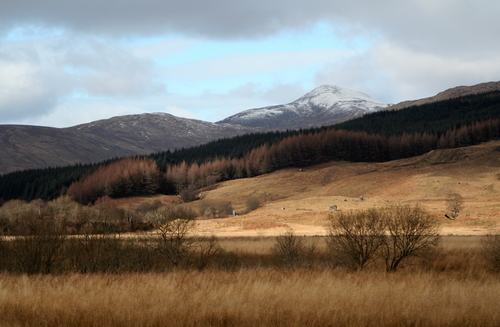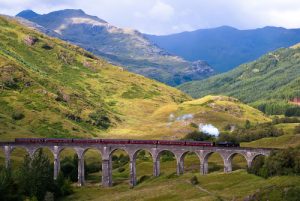These days, it seems, the buzz in travel circles is all about Europe's ultra-fast rail lines—those sleek Trains a Grande Vitesse or TGVs such as the Eurostar Chunnel train that zips under the English Channel between London and Paris in under three hours. These modern technological marvels dash along so fast that the countryside speeds by in a blur of green and brown, like a DVD player on fast-forward.
That's fine if you're in a hurry. It may be the way to commute, but it certainly isn't the way to travel. If you're into seeing the countryside, what you want is a ride aboard Europe's trains of no vitesse, "branch line" routes that are more about otherwise-inaccessible scenery than speed. These railways, engineering marvels from previous centuries, are Europe's forgotten trains, quirky little lines running through remote, hidden, but beautiful corners of Europe. Wrenched from the land by bold feats of engineering that even today seem improbable, they bore through mountains, snake along isolated river valleys, hug the sides of cliffs, clicketty-clack over impressive stone viaducts—all while traversing some of the most astounding views you'll find anywhere.
Sadly, many of these slow-track railways have fallen on hard times, their rights of way turned into bike or hiking paths, their stations sold at auction to urbanites looking for unusual country retreats. The remaining routes are an endangered species, under the constant scrutiny of railway officials and budget-constrained governments who'd close them were it not for the protests of rail fans and local residents who rely on the lines for basic transportation.
You can find these offbeat, remote railways in almost any European country, but four of my favorites are in Scotland, England, France and Italy. Unlike some of the privately-owned tourist trains, such as the cog railway that climbs up the Jungfraujoch in Switzerland, these trains offer scheduled services that carry farmers and housewives, students and even commuters, day in, day out, along with, of course, the occasional train nut (who, me?).

Glasgow-Mallaig
They're even patronized your everyday loveable nut, as I discovered on my first off-the-beaten track journey. Donald Monteith is the first person I meet on the 164-mile westerly run from Glasgow to Mallaig, Scotland, one of the planet's most scenic rail journeys. In a brogue as thick as Scottish porridge, he booms, "Tell me the best of your bad news!" as soon as I sit down across from him in the nearly empty two-car Diesel-powered train, whereupon he takes a long, premeditated slug from his hip flask, then gestures that I do the same. As we sway out of Glasgow's Queen Street Station, I examine him more carefully: he looks like he's just escaped from the set of a low-budget remake of Brigadoon. He wears a moth-eaten kilt (Graham of Monteith tartan, he proudly informs me), and a matching, similarly ravaged Inverness cape, accessorized with a sporran—a sort of fur-clad purse made from the carcass of a fox, its beady little eyes staring mournfully at me.
Outside the window, Glasgow's grim industrial core quickly gives way to a series of calm lochs, their distant shores barely visible in the morning fog and mist. On the left side, dramatic snow-capped mountains emerge, their peaks shrouded in clouds. The line has gone from two tracks to a single ribbon of steel that hugs a steep slope as we climb through pine forests. It looks like Switzerland without the chalets and cows—the only sign of civilization the occasional abandoned Victorian train station.
I overnight in Crianlarich, where the train divides in two sections, with one going to the coastal town of Oban, of single-malt Scotch fame, and the other for Mallaig, to which, the next morning, I continue on under blue skies.
Backpackers and a few uniformed school kids hop on and off at stations along the way. We cross the Rannoch Moor, 400 square miles of desolate peat blogs and small lochs (only the railway—no road—crosses it), and then traverse the spectacular Glenfinnan Viaduct. At Mallaig, I'll catch the ferry to the Isle of Skye, stay overnight, and then take a bus back to the mainland the rail station at Kyle, where trains leave for Inverness along yet another scenic line; lovely as it is, however, in my opinion that railway plays second fiddle to the Mallaig line.
Settle-Carlisle
It was precisely not to play second fiddle to the competition that, just south of the border in England, the Midland Railway Company built its 70-mile Settle-Carlisle Railway (1869-1876). Until its completion, the Midland had to pay had a competing railroad for running rights over its tracks to provide customers fast main line service from southern England to Scotland. The line was a huge undertaking, made more onerous by the difficult terrain through the Yorkshire Dales and Pennine Moors and by the management's decision to build through or across any obstacles—hill, dale, mountain, valley, moor—rather than skirt around them. During its heyday, dozens of trains plied the route each day. But by 1970, all but two stations had been closed, and British Rail sought permission to shut the line entirely; luckily, more than 20,000 people objected, and eventually it was saved and all stations reopened.
I begin my journey in Leeds, an industrial city some 40 miles to the south, aboard the same type of two-car, self-propelled train used on the Mallaig line. It's a gray and chilly March day, with no hint of spring's advent two days hence. Soon after setting off, factories and warehouses give way to white sheep grazing on startling green pastures. Once we reach Settle, several people get off with their shopping bags and backpacks. The towns and villages along the way sound as English as a cup of tea—Horton-in-Ribblesdale, Kirkby Stephen, Appleby—their stations made from yellow local limestone, with gray slate roofs and red clay chimney pots. We cross the famous 1,320-foot-long, 100-foot-high Ribblehead Viaduct, with its 24 arches, and the necks of my fellow riders crane to see the view. (For the record, this feat of Victorian know-how consumed approximately 30,000 cubic yards of brick and stone and 3,000 cubic yards of concrete.) The heather-covered moor it crosses redefines barren, but it is strangely beautiful, nonetheless, even on a bleak day.
As we pass through Appleby, a town of attractive shops and home of the Tufton Arms, an erstwhile coaching inn that is about as Olde England as it gets, it starts to snow lightly—so much for spring—and little flakes settle in the crevices along the stone walls in the nearly deserted station.

Nice-Digne
It snows, too, in the Alpine foothills just north of Nice, the site of yet another majestic line with a rich history. This route, from Nice to Digne, was carved out of, and into, the cliffs above the River Var during the years 1890-1912. At first a private railroad, it was brought under state control in 1933 and privatized again in 1972. In November 1994 the Var overflowed its banks, washing away bridges and track along the 151-kilometer line; service wasn't restored until April 1996 at a cost of $10 million.
As is the case with all of these historic lines, "real" people (not just train nuts) use Nice-Digne for basic transportion. For them and the hill and Alpine towns they live in, the route is a true lifeline. But I am here as an unabashed tourist. At the modern glass and stucco station in Nice, a group of hikers, including a set of identical twins, with identical braces on their identical teeth, mill about waiting to board, carrying enough climbing and hiking gear to scale Mt. Everest. We set off: The train meanders through Nice's back yards, where laundry flutters in the sun, and intersects city streets at crossings guarded by nothing more than a traffic light (improbably, the train stops to give cars the right of way). We're soon traveling about 40 miles an hour, the rails clattering and squealing as we follow twists in the river. Most of my fellow passengers have their noses embedded in their Nice-Matins, the front page crammed with headlines lamenting Europe's economic woes.
Perhaps the most seductive section of the route lies between Le Fugeret and Saint-Andre-des-Alpes, a scenic Alpine village. One strategy to enjoy the railway is to leave Nice in the early morning, get off in Saint-Andre-des-Alpes, explore and have lunch, and then take a mid afternoon return train, getting off in Entrevaux, where a hilltop castle awaits exploration, before taking the last train of the day back to Nice.
As I wait for the return trip, I chat with the stationmaster in St. Andre-des-Alpes, who informs me that on most Sundays during the summer local rail enthusiasts run stream trains along this route. "Ils sont tous fou," he exclaims, twirling a finger around his temple in universal sign language. I wonder if he thinks I'm a bit mad as well.
Nice-Cuneo
There are no steam trains—and no obviously crazy people—on the fourth and final oddball line on my itinerary, a route that runs from Nice to Cuneo in Italy. In fact, for most of its long and interesting life there were no trains at all on this little-known railway. Like the Nice-Digne line, this one is a marvel of audacious 19th-Century engineering, first begun in 1882, with time out for the First World War, and finished only in 1928. Eleven years later, World War II put and end to all service; almost all of its bridges and viaducts were bombed, and full service was reestablished only in 1979.
Since I'm staying in Nice, my plan is take the train north to a town called Breil sur Roya (a 90-minute journey), then transfer for Cuneo. From there, I'll return south to Ventimiglia, also in Italy, then switch to a train along the fabled Cote d'Azur back to Nice.
It seems like all the other passengers, most of whom are speaking Italian, know each other as I board in Nice; the men shake hands and the women peck each other on the cheek. As with the Nice-Digne line, my fellow riders ignore the scenery; only a backpacking teenager looks out the window. The train moves slowly, lurching along the single track. After about 20 minutes, we emerge into a valley with green, terraced hills dotted by pink stucco houses. Craggy outcroppings loom hundreds of feet above us. Hill towns appear, their red-roofed dwellings perching precariously like so many houses of cards on the slopes of the rocky hills.
This is a tantalizing, teasing journey. We play hide and seek with the scenery as the train darts in and out of tunnels; flashes of warm sunlight alternating with stretches of cold blackness—night, day, night, day. No sooner does an appealing vista appear—a small sandstone castle on a river, a sylvan waterfall, an intriguing hill town—than it's snatched away by a black hole.
These illusive, now-you-see-them-now-you-don't images are fitting metaphors for Europe's slow-track trains. Vestigial wonders from a distant past, they, too, could disappear in a flash. So I'm glad I didn’t wait too long to experience them. If you take them for a ride, I think you'll agree with me that Europe on the fast track is fine, but give my Europe on the slow track any day.
If you go…
Glasgow-Mallaig
Schedules, maps and fares can be found on the Scot Rail site here.
Settle-Carlisle
The Settle-Carlisle Partnership is a private organization dedicated to the preservation and promotion of the line.
Northern Rail operates trains on this route.
Nice-Digne
More information (in French) can be found on the Chemins de Fer Provence site here.
Nice-Cuneo
Trains can be jam packed in summer, as this blog about the line (in French) attests so it's best to travel off-season. In summer, some trains have a local guide offering commentary.
Trains are operated by SNCF, the French railways. Schedules can be found here.
To learn more about George Hobica, visit his profile on Google
Mallaig, Entrevaux, Crianlarich images via Shutterstock






